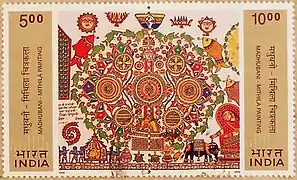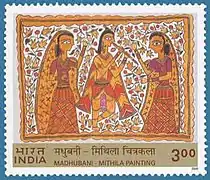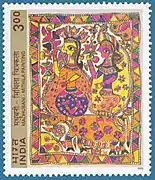Madhubani art
Madhubani art (also Mithila art) is a style of painting practiced in the Mithila region of India and Nepal. It is named after the Madhubani district of Bihar, India, which is where it originated. Artists create these paintings using a variety of mediums, including their own fingers, or twigs, brushes, nib-pens, and matchsticks. The paint is created using natural dyes and pigments. The paintings are characterised by their eye-catching geometrical patterns. There is ritual content for particular occasions, such as birth or marriage, and festivals, such as Holi, Surya Shasti, Kali Puja, Upanayana, and Durga Puja.

Origin and tradition
According to legend, Madhubani paintings were first created at Mithila, the birthplace of Hindu goddess Sita. When Sita and her husband Prince Rama were to be married, King Janak, father to Sita, asked for paintings to capture moments of the marriage. Madhubani painting (or Mithila painting) was traditionally created by the women of various communities in the Mithila region of the Indian subcontinent. It originated from Madhubani district of the Mithila region of Bihar. Madhubani is also a major export center of these paintings.[1] This painting as a form of wall art was practiced widely throughout the region; the more recent development of painting on paper and canvas mainly originated among the villages around Madhubani, and it is these latter developments that led to the term "Madhubani art" being used alongside "Mithila Painting."[2]
The paintings were traditionally done on freshly plastered mud walls and floors of huts, but now they are also done on cloth, handmade paper and canvas.[3] Madhubani paintings are made from the paste of powdered rice. Madhubani painting has remained confined to a compact geographical area and the skills have been passed on through centuries, the content and the style have largely remained the same. Thus, Madhubani painting has received GI (Geographical Indication) status. Madhubani paintings use two-dimensional imagery, and the colors used are derived from plants. Ochre, Lampblack and Red are used for reddish-brown and black, respectively.
Symbols
Mithila paintings mostly depict people and their association with nature and scenes and deities from the ancient epics. Natural objects like the sun, the moon, and religious plants like tulsi are also widely painted, along with scenes from the royal court and social events like weddings. In this paintings generally, no space is left empty; the gaps are filled by paintings of flowers, animals, birds, and even geometric designs.[4] Traditionally, painting was one of the skills that was passed down from generation to generation in the families of the Mithila Region, mainly by women .[5] It is still practiced and kept alive in institutions spread across the Mithila region. Asha Jha of Madhubanipaints in Darbhanga,[6] Vaidehi in Madhubani, Benipatti in Madhubani district and Gram Vikas Parishad in Ranti are some of the major centres of Madhubani painting which have kept this ancient art form alive.
Styles

Mithila art has five distinctive styles:
- Bharni
- Katchni
- Tantrik
- Godna
- Kohbar
In the 1960s Bharni, and Tantrik styles were mainly done by Brahman women in India and Nepal. Their themes were mainly religious and they depicted Gods and Goddesses paintings. People of other castes included aspects of their daily life and symbols, the story of Raja Shailesh (guard of the village) and much more, in their paintings. Nowadays Madhubani art has become a globalised art form, so there is no difference in the work on the basis of the caste system. They work in all five styles. Mithila art has received worldwide attention.[7][8]
Contributions
The Madhubani painting tradition played a key role in the conservation efforts in India in 2012, where there was frequent deforestation in the state of Bihar. Gram Vikas Parishad, an NGO, started the initiative as an attempt to protect local trees that were being cut down in the name of expanding roads and development. The main reason behind this was that the trees were traditionally adorned with forms of gods and other religious and spiritual images such as those of Radha-Krishna, Rama-Sita, scenes from Ramayana and Mahabharata and other epics.
Awards
Madhubani painting received official recognition in 1969 when Sita Devi received the State award by Government of Bihar. Mamta Devi from the village Jitwarpur has also got National Award. Jagdamba Devi from Bhajparaul, Madhubani was given Padma Shri in 1975 and the National Award to Sita Devi of Jitwarpur village near Madhubani.[9][10] Jagdamba Devi's foster son Satya Narayan Lal Karn and his wife Moti Karn are also well-regarded Mithila artists, and they won the National Award jointly in 2003. Sita Devi received the Padma Shri in 1981. Sita Devi was also awarded by Bihar Ratna in 1984 and Shilp Guru in 2006.
In 1984 Ganga Devi was awarded by Padma Shri.[11][12] Mahasundari Devi received the Padma Shri in 2011. Baua Devi, Yamuna Devi, Shanti Devi, Chano Devi, Bindeshwari Devi, Chandrakala Devi, Shashi kala Devi, Leela Devi, Godavari Dutta, Asha Jha Tira Devi and Bharti Dayal were also given the National award.[13][14][15] Chandrabhushan (Rasidpur), Ambika Devi (Rasidpur), Manisha Jha were also given the National award. In 2020, Madhubani artist Dulari Devi won the Padma Shri for contributions to art.[16]
Gallery
References
- Madhubani Painting. Abhinav Publications. 30 September 2017. ISBN 9788170171560. Archived from the original on 21 February 2017 – via Google Books.
- Carolyn Brown Heinz, 2006, "Documenting the Image in Mithila Art," Visual Anthropology Review, Vol. 22, Issue 2, pp. 5-33
- Krupa, Lakshmi (4 January 2013). "Madhubani walls". The Hindu. Archived from the original on 29 January 2014. Retrieved 5 February 2014.
- "Unleashing The Vibrant World Of Madhubani Painting".
- "Know India: Madhubani Painting". India.gov.in. Archived from the original on 7 September 2011. Retrieved 21 September 2013.
- "Kalakriti Mithila painting - Wikimapia". wikimapia.org. Archived from the original on 10 May 2017.
- "पटना के ने में मधुबनी बनायीं". atulyabihar.com (in Hindi). 1 September 2018. Archived from the original on 10 September 2018. Retrieved 10 September 2018.
- Authindia. "Types of Madhubani Painting". Authindia. Archived from the original on 27 May 2021. Retrieved 27 May 2021.
- "Jagdamba Devi – UMSAS". Archived from the original on 20 May 2021. Retrieved 20 May 2021.
- "Padma Shri" (PDF). Padma Shri. 2015. Archived from the original (PDF) on 15 October 2015. Retrieved 11 November 2014.
- "Padma Awards" (PDF). Ministry of Home Affairs, Government of India. 2015. Archived from the original (PDF) on 15 October 2015. Retrieved 21 July 2015.
- Jyotindra Jain (1989). "Ganga Devi: Tradition and expression in Madhubani painting". Third Text. 3 (6): 43–50. doi:10.1080/09528828908576213.
- Thakur, Upendra (1981). Madhubani painting – Upendra Thakur – Google Boeken. ISBN 9780391024113. Archived from the original on 11 June 2022. Retrieved 21 September 2013.
- Tripathi, Shailaja (22 November 2013). "Madhubani beyond the living rooms". The Hindu. Archived from the original on 31 January 2014. Retrieved 3 February 2014.
- "Art that subverts". The Hindu. 26 August 2013. Archived from the original on 26 August 2013 – via www.thehindu.com.
- "Padma Shri Ramchandra Manjhi and Dulari Devi: Tale of two artists, and of art, caste and grit in Bihar". The Indian Express. 7 February 2021. Archived from the original on 18 February 2021. Retrieved 25 February 2021.
Further reading
- Kossak, Steven (1997). Indian court painting, 16th-19th century.. New York: The Metropolitan Museum of Art. ISBN 978-0-87099-783-9. (see index: p. 148–152)
- Old Traditional art by rural women, from Madhubani art gallery.


